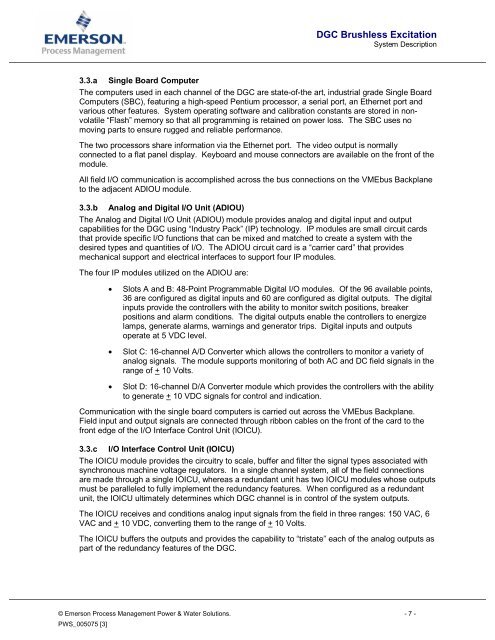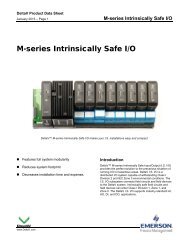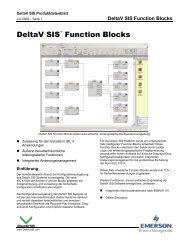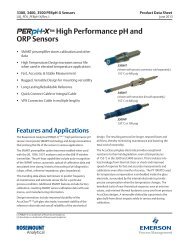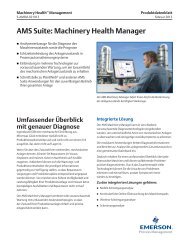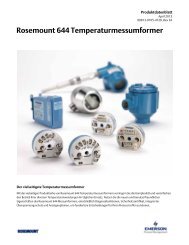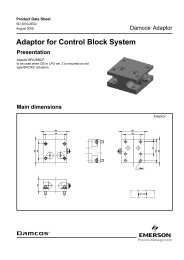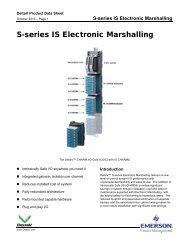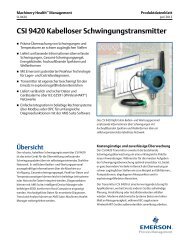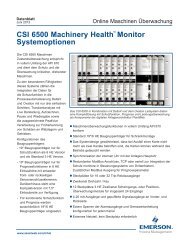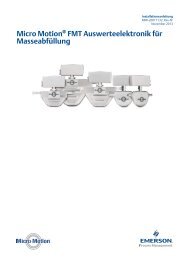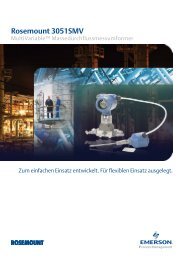DGC Brushless Excitation - Emerson Process Management
DGC Brushless Excitation - Emerson Process Management
DGC Brushless Excitation - Emerson Process Management
Create successful ePaper yourself
Turn your PDF publications into a flip-book with our unique Google optimized e-Paper software.
<strong>DGC</strong> <strong>Brushless</strong> <strong>Excitation</strong><br />
System Description<br />
3.3.a Single Board Computer<br />
The computers used in each channel of the <strong>DGC</strong> are state-of-the art, industrial grade Single Board<br />
Computers (SBC), featuring a high-speed Pentium processor, a serial port, an Ethernet port and<br />
various other features. System operating software and calibration constants are stored in nonvolatile<br />
“Flash” memory so that all programming is retained on power loss. The SBC uses no<br />
moving parts to ensure rugged and reliable performance.<br />
The two processors share information via the Ethernet port. The video output is normally<br />
connected to a flat panel display. Keyboard and mouse connectors are available on the front of the<br />
module.<br />
All field I/O communication is accomplished across the bus connections on the VMEbus Backplane<br />
to the adjacent ADIOU module.<br />
3.3.b Analog and Digital I/O Unit (ADIOU)<br />
The Analog and Digital I/O Unit (ADIOU) module provides analog and digital input and output<br />
capabilities for the <strong>DGC</strong> using “Industry Pack” (IP) technology. IP modules are small circuit cards<br />
that provide specific I/O functions that can be mixed and matched to create a system with the<br />
desired types and quantities of I/O. The ADIOU circuit card is a “carrier card” that provides<br />
mechanical support and electrical interfaces to support four IP modules.<br />
The four IP modules utilized on the ADIOU are:<br />
• Slots A and B: 48-Point Programmable Digital I/O modules. Of the 96 available points,<br />
36 are configured as digital inputs and 60 are configured as digital outputs. The digital<br />
inputs provide the controllers with the ability to monitor switch positions, breaker<br />
positions and alarm conditions. The digital outputs enable the controllers to energize<br />
lamps, generate alarms, warnings and generator trips. Digital inputs and outputs<br />
operate at 5 VDC level.<br />
• Slot C: 16-channel A/D Converter which allows the controllers to monitor a variety of<br />
analog signals. The module supports monitoring of both AC and DC field signals in the<br />
range of + 10 Volts.<br />
• Slot D: 16-channel D/A Converter module which provides the controllers with the ability<br />
to generate + 10 VDC signals for control and indication.<br />
Communication with the single board computers is carried out across the VMEbus Backplane.<br />
Field input and output signals are connected through ribbon cables on the front of the card to the<br />
front edge of the I/O Interface Control Unit (IOICU).<br />
3.3.c I/O Interface Control Unit (IOICU)<br />
The IOICU module provides the circuitry to scale, buffer and filter the signal types associated with<br />
synchronous machine voltage regulators. In a single channel system, all of the field connections<br />
are made through a single IOICU, whereas a redundant unit has two IOICU modules whose outputs<br />
must be paralleled to fully implement the redundancy features. When configured as a redundant<br />
unit, the IOICU ultimately determines which <strong>DGC</strong> channel is in control of the system outputs.<br />
The IOICU receives and conditions analog input signals from the field in three ranges: 150 VAC, 6<br />
VAC and + 10 VDC, converting them to the range of + 10 Volts.<br />
The IOICU buffers the outputs and provides the capability to “tristate” each of the analog outputs as<br />
part of the redundancy features of the <strong>DGC</strong>.<br />
© <strong>Emerson</strong> <strong>Process</strong> <strong>Management</strong> Power & Water Solutions. - 7 -<br />
PWS_005075 [3]


